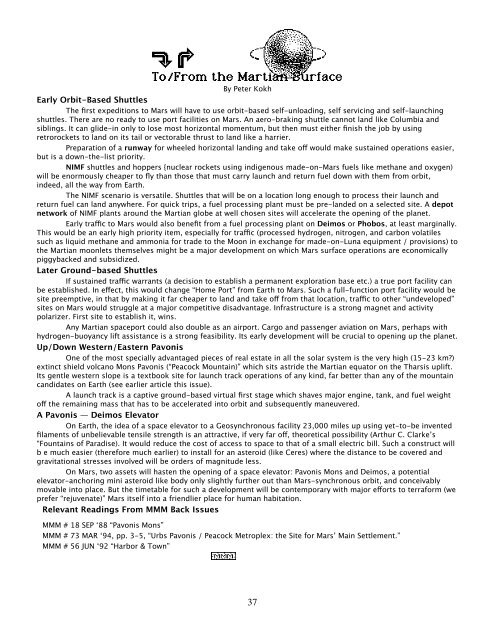Space Transportation - mmmt_transportation.pdf - Moon Society
Space Transportation - mmmt_transportation.pdf - Moon Society
Space Transportation - mmmt_transportation.pdf - Moon Society
You also want an ePaper? Increase the reach of your titles
YUMPU automatically turns print PDFs into web optimized ePapers that Google loves.
By Peter Kokh<br />
Early Orbit-Based Shuttles<br />
The first expeditions to Mars will have to use orbit-based self-unloading, self servicing and self-launching<br />
shuttles. There are no ready to use port facilities on Mars. An aero-braking shuttle cannot land like Columbia and<br />
siblings. It can glide-in only to lose most horizontal momentum, but then must either finish the job by using<br />
retrorockets to land on its tail or vectorable thrust to land like a harrier.<br />
Preparation of a runway for wheeled horizontal landing and take off would make sustained operations easier,<br />
but is a down-the-list priority.<br />
NIMF shuttles and hoppers {nuclear rockets using indigenous made-on-Mars fuels like methane and oxygen)<br />
will be enormously cheaper to fly than those that must carry launch and return fuel down with them from orbit,<br />
indeed, all the way from Earth.<br />
The NIMF scenario is versatile. Shuttles that will be on a location long enough to process their launch and<br />
return fuel can land anywhere. For quick trips, a fuel processing plant must be pre-landed on a selected site. A depot<br />
network of NIMF plants around the Martian globe at well chosen sites will accelerate the opening of the planet.<br />
Early traffic to Mars would also benefit from a fuel processing plant on Deimos or Phobos, at least marginally.<br />
This would be an early high priority item, especially for traffic (processed hydrogen, nitrogen, and carbon volatiles<br />
such as liquid methane and ammonia for trade to the <strong>Moon</strong> in exchange for made-on-Luna equipment / provisions) to<br />
the Martian moonlets themselves might be a major development on which Mars surface operations are economically<br />
piggybacked and subsidized.<br />
Later Ground-based Shuttles<br />
If sustained traffic warrants (a decision to establish a permanent exploration base etc.) a true port facility can<br />
be established. In effect, this would change “Home Port” from Earth to Mars. Such a full-function port facility would be<br />
site preemptive, in that by making it far cheaper to land and take off from that location, traffic to other “undeveloped”<br />
sites on Mars would struggle at a major competitive disadvantage. Infrastructure is a strong magnet and activity<br />
polarizer. First site to establish it, wins.<br />
Any Martian spaceport could also double as an airport. Cargo and passenger aviation on Mars, perhaps with<br />
hydrogen-buoyancy lift assistance is a strong feasibility. Its early development will be crucial to opening up the planet.<br />
Up/Down Western/Eastern Pavonis<br />
One of the most specially advantaged pieces of real estate in all the solar system is the very high (15-23 km?)<br />
extinct shield volcano Mons Pavonis (“Peacock Mountain)” which sits astride the Martian equator on the Tharsis uplift.<br />
Its gentle western slope is a textbook site for launch track operations of any kind, far better than any of the mountain<br />
candidates on Earth (see earlier article this issue).<br />
A launch track is a captive ground-based virtual first stage which shaves major engine, tank, and fuel weight<br />
off the remaining mass that has to be accelerated into orbit and subsequently maneuvered.<br />
A Pavonis — Deimos Elevator<br />
On Earth, the idea of a space elevator to a Geosynchronous facility 23,000 miles up using yet-to-be invented<br />
filaments of unbelievable tensile strength is an attractive, if very far off, theoretical possibility (Arthur C. Clarke’s<br />
“Fountains of Paradise). It would reduce the cost of access to space to that of a small electric bill. Such a construct will<br />
b e much easier (therefore much earlier) to install for an asteroid (like Ceres) where the distance to be covered and<br />
gravitational stresses involved will be orders of magnitude less.<br />
On Mars, two assets will hasten the opening of a space elevator: Pavonis Mons and Deimos, a potential<br />
elevator-anchoring mini asteroid like body only slightly further out than Mars-synchronous orbit, and conceivably<br />
movable into place. But the timetable for such a development will be contemporary with major efforts to terraform (we<br />
prefer “rejuvenate)” Mars itself into a friendlier place for human habitation.<br />
Relevant Readings From MMM Back Issues<br />
MMM # 18 SEP ‘88 “Pavonis Mons”<br />
MMM # 73 MAR ‘94, pp. 3-5, “Urbs Pavonis / Peacock Metroplex: the Site for Mars’ Main Settlement.”<br />
MMM # 56 JUN ‘92 “Harbor & Town”<br />
37















